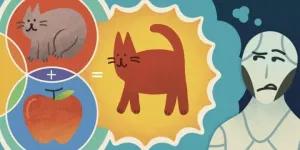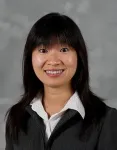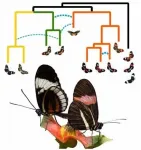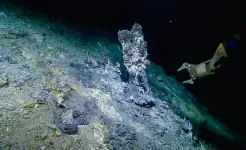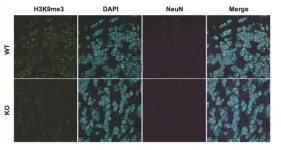(Press-News.org) Imagine an orange cat. Now, imagine the same cat, but with coal-black fur. Now, imagine the cat strutting along the Great Wall of China. Doing this, a quick series of neuron activations in your brain will come up with variations of the picture presented, based on your previous knowledge of the world.
In other words, as humans, it's easy to envision an object with different attributes. But, despite advances in deep neural networks that match or surpass human performance in certain tasks, computers still struggle with the very human skill of "imagination."
Now, a USC research team has developed an AI that uses human-like capabilities to imagine a never-before-seen object with different attributes. The paper, titled Zero-Shot Synthesis with Group-Supervised Learning, was published in the 2021 International Conference on Learning Representations on May 7.
"We were inspired by human visual generalization capabilities to try to simulate human imagination in machines," said the study's lead author Yunhao Ge, a computer science PhD student working under the supervision of Laurent Itti, a computer science professor.
"Humans can separate their learned knowledge by attributes--for instance, shape, pose, position, color--and then recombine them to imagine a new object. Our paper attempts to simulate this process using neural networks."
AI's generalization problem
For instance, say you want to create an AI system that generates images of cars. Ideally, you would provide the algorithm with a few images of a car, and it would be able to generate many types of cars--from Porsches to Pontiacs to pick-up trucks--in any color, from multiple angles.
This is one of the long-sought goals of AI: creating models that can extrapolate. This means that, given a few examples, the model should be able to extract the underlying rules and apply them to a vast range of novel examples it hasn't seen before. But machines are most commonly trained on sample features, pixels for instance, without taking into account the object's attributes.
The science of imagination
In this new study, the researchers attempt to overcome this limitation using a concept called disentanglement. Disentanglement can be used to generate deepfakes, for instance, by disentangling human face movements and identity. By doing this, said Ge, "people can synthesize new images and videos that substitute the original person's identity with another person, but keep the original movement."
Similarly, the new approach takes a group of sample images--rather than one sample at a time as traditional algorithms have done--and mines the similarity between them to achieve something called "controllable disentangled representation learning."
Then, it recombines this knowledge to achieve "controllable novel image synthesis," or what you might call imagination. "For instance, take the Transformer movie as an example" said Ge, "It can take the shape of Megatron car, the color and pose of a yellow Bumblebee car, and the background of New York's Times Square. The result will be a Bumblebee-colored Megatron car driving in Times Square, even if this sample was not witnessed during the training session."
This is similar to how we as humans extrapolate: when a human sees a color from one object, we can easily apply it to any other object by substituting the original color with the new one. Using their technique, the group generated a new dataset containing 1.56 million images that could help future research in the field.
Understanding the world
While disentanglement is not a new idea, the researchers say their framework can be compatible with nearly any type of data or knowledge. This widens the opportunity for applications. For instance, disentangling race and gender-related knowledge to make fairer AI by removing sensitive attributes from the equation altogether.
In the field of medicine, it could help doctors and biologists discover more useful drugs by disentangling the medicine function from other properties, and then recombining them to synthesize new medicine. Imbuing machines with imagination could also help create safer AI by, for instance, allowing autonomous vehicles to imagine and avoid dangerous scenarios previously unseen during training.
"Deep learning has already demonstrated unsurpassed performance and promise in many domains, but all too often this has happened through shallow mimicry, and without a deeper understanding of the separate attributes that make each object unique," said Laurent Itti, a professor of computer science. "This new disentanglement approach, for the first time, truly unleashes a new sense of imagination in A.I. systems, bringing them closer to humans' understanding of the world."
INFORMATION:
BUFFALO, N.Y. - Many legacy media outlets played an unwitting role in the growth of the four most successful fake Twitter accounts hosted by the Russian Internet Research Agency (IRA) that were created to spread disinformation during the 2016 U.S. presidential campaign, according to a study led by a University at Buffalo communication researcher.
In roughly two years beginning in late 2015, these accounts went from obscurity to microcelebrity status, growing from about 100 to more than 100,000 followers. With its heavily populated follower base ready to spread the word -- like all heavily engaged Twitter audiences -- the IRA could strategically deploy messages and provide visible metrics, creating an illusion of authority and ...
As the Covid-19 pandemic raged, news reports show that sales of electronic air cleaners have surged due to concerns about airborne disease transmission. But a research team at the Georgia Institute of Technology has found that the benefits to indoor air quality of one type of purifying system can be offset by the generation of other pollutants that are harmful to health.
Led by Associate Professor Nga Lee "Sally" Ng in Georgia Tech's School of Chemical and Biomolecular Engineering and the School of Earth and Atmospheric Sciences, the team evaluated the effect of a hydroxyl radical generator in an office setting. Hydroxyl radicals react with odors and pollutants, decomposing ...
A team of researchers from the University of Maryland has 3D printed a soft robotic hand that is agile enough to play Nintendo's Super Mario Bros. - and win!
The feat, highlighted on the front cover of the latest issue of Science Advances, demonstrates a promising innovation in the field of soft robotics, which centers on creating new types of flexible, inflatable robots that are powered using water or air rather than electricity. The inherent safety and adaptability of soft robots has sparked interest in their use for applications like prosthetics and biomedical devices. Unfortunately, controlling the fluids that make these soft ...
Evolution is often portrayed as a tree, with new species branching off from existing lineages, never again to meet. The truth however is often much messier. In the case of adaptive radiation, in which species diversify rapidly to fill different ecological niches, it can be difficult to resolve relationships, and the phylogeny (i.e. evolutionary tree) may look more like a bush than a tree. This is because lineages may continue to interbreed as new species are established, and/or they may diverge and then re-hybridize, resulting in genetically mixed populations (known as admixture). Even after species diverge, the introduction of genes from one species to another (known as introgression) can occur. All of ...
A UC San Francisco study has found that the antibiotic azithromycin was no more effective than a placebo in preventing symptoms of COVID-19 among non-hospitalized patients, and may increase their chance of hospitalization, despite widespread prescription of the antibiotic for the disease.
"These findings do not support the routine use of azithromycin for outpatient SARS-CoV-2 infection," said lead author Catherine E. Oldenburg, ScD, MPH, an assistant professor with the UCSF Proctor Foundation. SARS-CoV-2 is the virus that causes COVID-19.
Azithromycin, a broad-spectrum antibiotic, is widely prescribed as a treatment for COVID-19 in the United States and the rest of the world. "The hypothesis is that it has anti-inflammatory properties that ...
ATLANTA--An oral prodrug developed by a team of scientists led by Binghe Wang, Regents' Professor of Chemistry at Georgia State University, delivers carbon monoxide to protect against acute kidney injury, according to a new paper published in Chemical Science.
Although carbon monoxide (CO) gas is toxic in large doses, scientists have discovered it can have beneficial effects by reducing inflammation and protecting cells against injury. Previous studies have demonstrated the protective effects of CO against injury in the kidneys, lungs, gastrointestinal tract and liver, among other organs. For the past five years, Wang and his collaborators have worked to design a safe way to deliver CO to human patients via prodrugs -- inactive compounds that ...
The COVID-19 pandemic knocked many women off schedule for important health appointments, a new study finds, and many didn't get back on schedule even after clinics reopened. The effect may have been greatest in areas where such care is already likely falling behind experts' recommendations.
The study, by health care researchers in the University of Michigan END ...
The hydrothermal vent fluids from the Gorda Ridge spreading center in the northeast Pacific Ocean create a biological hub of activity in the deep sea. There, in the dark ocean, a unique food web thrives not on photosynthesis but rather on chemical energy from the venting fluids. Among the creatures having a field day feasting at the Gorda Ridge vents is a diverse assortment of microbial eukaryotes, or protists, that graze on chemosynthetic bacteria and archaea.
This protistan grazing, which is a key mechanism for carbon transport and recycling in microbial food webs, exerts a higher predation pressure at hydrothermal vent sites than in the surrounding deep-sea environment, a new paper finds.
"Our ...
Vaccine negativity and reluctance didn't just emerge during the COVID-19 pandemic. In a recent study published in the Disaster Medicine and Public Health Preparedness journal, authors from Loyola University Maryland and Johns Hopkins Bloomberg School of Public Health explored the appearance of negative dominance - a concept in which negative messages outweigh positive, solution-oriented messages in audiences' perceptions - in the context of COVID-19 vaccine-related information and activity online.
Prior research has looked at media coverage to identify vaccine concerns among the public and its impact on vaccine-related beliefs and behaviors, the spread of misinformation and fake news on the Internet, and the role ...
New research from the RIKEN Center for Brain Science (CBS) in Japan shows that a deficit in histone methylation could lead to the development of autism spectrum disorders (ASD). A human variant of the SUV39H2 gene led researchers to examine its absence in mice. Published in Molecular Psychiatry, the study found that when absent, adult mice exhibited cognitive inflexibility similar to what occurs in autism, and embryonic mice showed misregulated expression of genes related to brain development. These findings represent the first direct link between the SUV39H2 gene and ASD.
Genes are turned ...
